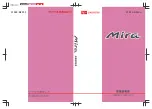
Occupant safety
53
increase the chance of head and neck
injuries. The seat belt would also apply
too much force to the ribs or abdomen,
which could severely injure internal
organs such as your liver or spleen.
Adjust the seat belt so that the shoulder
section is located as close as possible to
the middle of the shoulder (it should not
touch the neck). Never pass the shoulder
portion of the seat belt under your arm.
R
Position the lap belt as low as possible
on your hips and not across the
abdomen. If the lap belt is positioned
across your abdomen, it could cause
serious injuries in a crash.
R
Never wear seat belts over rigid or
breakable objects in or on your clothing,
such as eyeglasses, pens, keys etc., as
these might cause injuries.
R
Make sure the seat belt is always fitted
snugly. Take special care of this when
wearing loose clothing.
R
Never use a seat belt for more than one
person at a time. Do not fasten a seat belt
around a person and another person or
other objects at the same time.
R
Seat belts should not be worn twisted. In
a crash, you would not have the full width
of the seat belt to distribute impact
forces. The twisted seat belt against your
body could cause injuries.
R
Pregnant women should also always use
a lap/shoulder belt. The lap belt portion
should be positioned as low as possible
on the hips to avoid any possible
pressure on the abdomen.
R
Place the seat backrest in a position that
is as upright as possible.
R
Check your seat belt during travel to
make sure it is properly positioned.
R
Never place your feet on the instrument
panel, dashboard, or on the seat. Always
keep both feet on the floor in front of the
seat.
R
When using a seat belt to secure infant
restraints, toddler restraints, or children
in booster seats, always follow the child
seat manufacturer’s instructions.
G
Warning!
Do not pass seat belts over sharp edges.
They could tear.
Do not allow the seat belt to get caught in
the door or in the seat adjustment
mechanism. This could damage the seat
belt.
Never attempt to make modifications to
seat belts. This could impair the
effectiveness of the seat belts.
Fastening the seat belts
G
Warning!
According to accident statistics, children
are safer when properly restrained in the
rear seating positions than in the front
seating position. Thus, we strongly
recommend that children be placed in the
rear seats whenever possible. Regardless
of seating position, children 12 years old
and under must be seated and properly
secured in an appropriately sized infant
restraint, toddler restraint, or booster seat
recommended for the size and weight of the
child. For additional information, see
“Children in the vehicle”.
A child’s risk of serious or fatal injuries is
significantly increased if the child restraints
are not properly secured in the vehicle
and/or the child is not properly secured in
the child restraint.
Safety and security
Z
Содержание 2009 CLK-Class
Страница 1: ...CLK Operator s Manual...
Страница 26: ...24...
Страница 28: ...Exterior view 26 Exterior view At a glance...
Страница 30: ...Exterior view 28 At a glance...
Страница 32: ...Cockpit 30 Cockpit At a glance...
Страница 34: ...Instrument cluster 32 Instrument cluster At a glance...
Страница 147: ...Audio system 145 Operating and display elements Controls in detail Z...
Страница 226: ...224...
Страница 276: ...274...
Страница 309: ...Vehicle status messages in the multifunction display 307 Practical hints Z...
Страница 360: ...358...
Страница 384: ...Order no 6515 1338 13 Part no 209 584 44 97 Edition A 2009 2095844497h 2095844497...
















































